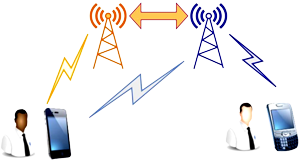Interleaver assignment solution for multi radio access technology supported 5G networks
DOI:
https://doi.org/10.3103/S0735272721020059Keywords:
5G, multi-RAT, signaling, fallback, interleaver assignmentAbstract
Fifth Generation (5G) communication networks support multiple radio access technologies, popularly known as multi-RAT, to facilitate services to all the mobile subscribers irrespective of their subscription for any old generation network. Unique interleaver assignment to each active mobile subscriber within intra-RAT communication is comparatively easy task. However, the same becomes a challenging issue when multi-RAT supported communication is required to be dealt with. This paper reveals a theoretical backend control signaling solution to overcome this challenge. The proposed solution is named as Store-Regenerate-Recall (SRR) technique for interleaver assignment in multi-RAT supported 5G network. This solution is quite effective and easy-to-implement for handling interleaver assignment issue at the 5G network end in multi-RAT scenarios without any subscriber identity clash. Overall, the method is of great significance when multi-carrier multi-RAT solutions are intended to be developed for 5G networks.
References
- S. Chandrashekar, A. Maeder, C. Sartori, T. Hohne, B. Vejlgaard, D. Chandramouli, “5G multi-RAT multi-connectivity architecture,” in 2016 IEEE International Conference on Communications Workshops (ICC), 2016, pp. 180–186, doi: https://doi.org/10.1109/ICCW.2016.7503785.
- S. Borst, A. O. Kaya, D. Calin, H. Viswanathan, “Dynamic path selection in 5G multi-RAT wireless networks,” in IEEE INFOCOM 2017 - IEEE Conference on Computer Communications, 2017, pp. 1–9, doi: https://doi.org/10.1109/INFOCOM.2017.8057228.
- R. P. Antonioli, E. B. Rodrigues, D. A. Sousa, I. M. Guerreiro, C. F. M. e Silva, F. R. P. Cavalcanti, “Adaptive bearer split control for 5G multi-RAT scenarios with dual connectivity,” Comput. Networks, vol. 161, pp. 183–196, 2019, doi: https://doi.org/10.1016/j.comnet.2019.07.005.
- H. Kim, J. Ryu, S. Park, M. Youn, “Method and user equipment for fallback for voice call from 5G mobile communication to 4G,” US Patent 20190191349, 2019.
- 3GPP, “TS 23.502 version 15.2.0 Release 155G,” in Procedures for the 5G System, 2018.
- B. Y. Kong, I.-C. Park, “Efficient implementation of multiple interleavers in IDMA for 5G,” in 2018 International SoC Design Conference (ISOCC), 2018, pp. 119–120, doi: https://doi.org/10.1109/ISOCC.2018.8649984.
- R. Garzon-Bohorquez, C. A. Nour, C. Douillard, “Improving turbo codes for 5G with parity puncture-constrained interleavers,” in 2016 9th International Symposium on Turbo Codes and Iterative Information Processing (ISTC), 2016, vol. 2016-Octob, pp. 151–155, doi: https://doi.org/10.1109/ISTC.2016.7593095.
- M. Yadav, V. Shokeen, P. Kumar Singhal, “Flip left-right approach based novel inverse tree interleavers for IDMA scheme,” AEU - Int. J. Electron. Commun., vol. 81, pp. 182–191, 2017, doi: https://doi.org/10.1016/j.aeue.2017.07.025.
- M. Yadav, V. Shokeen, P. K. Singhal, “Flip left-to-right approach based inverse tree interleavers for unconventional integrated OFDM-IDMA and SCFDMA-IDMA systems,” Wirel. Pers. Commun., vol. 105, no. 3, pp. 1009–1026, 2019, doi: https://doi.org/10.1007/s11277-019-06133-3.
- A. Galanopoulos, F. Foukalas, T. A. Tsiftsis, “Multi-RAT aggregation through spectrum reallocation for future wireless networks,” Wirel. Pers. Commun., vol. 111, no. 3, pp. 1545–1562, 2020, doi: https://doi.org/10.1007/s11277-019-06939-1.
- V. F. Monteiro, M. Ericson, F. R. P. Cavalcanti, “Fast-RAT scheduling in a 5G multi-RAT scenario,” IEEE Commun. Mag., vol. 55, no. 6, pp. 79–85, 2017, doi: https://doi.org/10.1109/MCOM.2017.1601094.
- S. H. Chae, J.-P. Hong, W. Choi, “Optimal access in OFDMA multi-RAT cellular networks: can a single RAT be better?,” IEEE Trans. Wirel. Commun., vol. 15, no. 7, pp. 1–1, 2016, doi: https://doi.org/10.1109/TWC.2016.2546239.
- M. Yadav, V. Shokeen, P. K. Singhal, “Uncoded integrated interleave division multiple access systems in presence of power interleavers,” Radioelectron. Commun. Syst., vol. 60, no. 11, pp. 503–511, 2017, doi: https://doi.org/10.3103/S073527271711005X.


